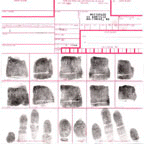| Author | Message | ||
Ed German |
You asked, "Is there a specific reason for this?" Probably not. On an adult fingerprint card for recording criminal arrests or applying for a gun permit, etc., there are rolled impressions in each of the ten finger blocks, and also plain (also called simultaneous) impressions of four fingers at a time on the bottom of the card on both sides of the thumbs (on US format fingerprint cards).  The purposes of plain impressions on fingerprint cards are: 1. To verify proper sequence of fingers in appropriate blocks. 2. To provide a second chance to see ridge detail that may be smudged or missing in the rolled impression above. Because children's fingerprints are taken either as a learning novelty or as a public service for parents (if the child should disappear), not all ten prints are necessary. A child can be just as easily identified from one very legible fingerprint as from all ten (or from one big toe print... which is often even more legible than the relatively smaller ridge detail on children's fingers). The advantage of having the equivalent of a miniature fingerprint card from children is that it facilitates FBI NCIC encoding (pattern classification) for entry into missing person databases. When your child has disappeared, you want them entered into every possible tracking database in existence. Such (complete) fingerprint records can also be entered (if legible) into an AFIS database. Having just one thumbprint (for example) though does not mean it cannot be put into AFIS. It can be entered as a latent print (like a thumbprint found at a burglary) to cause a "hit" should the same person's fingerprint card ever come through the system. If you want to take very legible prints of your child, try using Scotch tape (or similar clear plastic tape) and rub the child's finger/hand with either a charcoal pencil or a (cold, of course) charcoal briquet. You can lift the charcoal coating from the fingers and put the tape on a piece of paper. The impressions will be mirror image reversed from normal inked prints, but typically have much greater detail for identfication purposes. An alternative which also easily permits recording the entire palms and feet (I used this for my kids when they were toddlers) is shelving paper. Touch the charcoal-coated hand or foot onto the adhesive surface and then press the adhesive onto a piece of clear plastic (such as a document protector or "report cover"). Experiment and you may soon have your own child's fingerprints in better detail than anything you get from a school or police department demonstration. Best wishes, Ed German | ||
Linda Pearsall |
By Linda Pearsall on Monday, May 22, 2000 - 09:46 pm: Hi, I've noticed that some of my friends' children are fingerprinted one finger at a time. Sometimes, the 4 fingers are printed simultaneously, and then the thumb is printed. Is there a specific reason for this? Thanks, Linda |